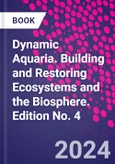Dynamic Aquaria: Building and Restoring Ecosystems and the Biosphere, Fourth Edition demonstrates how the living systems modeling of aquatic ecosystems for ecological, biological, physiological research, and ecosystem restoration produce answers to very complex ecological questions. The book describes unique characteristics of water that have allowed carbon chemistry to flourish and evolve life over 4 billion years, along with current disruptions such as global warming, overfishing, and chemical pollution. New content in this edition includes the use of LED lighting, DNA sequencing in microcosm construction and analysis, and the expansion of the bioengineered tool Algal Turf Scrubbing (ATS) to combat global pollution problems.
The book also features new information on marine calcification, research microcosms, thermogeography, and methods of water movement for minimizing plankton loss. It supports a deeper biological and ecological intelligence among the human population to better understand the processes behind environmental issues.
Please Note: This is an On Demand product, delivery may take up to 11 working days after payment has been received.
Table of Contents
1. Introduction
Part I: Physical Environment
2. Physical Parameters and Energy State
3. Substrate
Controlling the Benthic Component
4. Water Composition
Management of Salinity, Hardness, and Evaporation
5. The Input of Solar Energy
Lighting and New Possibilities
6. The Input of Organic Energy
Particulates and Feeding
Part II: Biochemical Environment
7. Metabolism
Respiration, Photosynthesis, and Biological Loading
8. Organisms and Gas Exchange
Oxygen, Carbon Dioxide, pH, and Alkalinity
9. Primary Nutrients
Nitrogen, Phosphorus, and Silica
10. Biomineralization and Calcification
A Key to Biosphere and Ecosystem Function
11. Control of the Biochemical Environment
3D Potential for Algal Turf Scrubbing
Part III: Biological Structure
12. Community Structure
Biodiversity in Model Ecosystems
13. Thermogeography
The Distribution of Organisms Along Coasts
14. Trophic Structure
Ecosystems and Dynamics of Food Chains
15. Primary Producers
Bottom-Growing Plants
16. Herbivores
17. Carnivores
18. Plankton and Planktivores
19. Detritus and Detritivores
20. Symbionts and Other Feeders
Part IV: Ecological Systems in Microcosms, Mesocosms, and Aquaria
21. Models of Coral Reef Ecosystems
22. Subarctic/Boreal Microcosm
Applications of New Research
23. Estuaries
Ecosystem Modelling and Restoration
24. Freshwater Ecosystem Models
25. Research Systems in Microcosms
Part V: The Environment and Ecological Engineering
26. Organisms and Natural Products
27. Large Scale Water Quality Management with Solar Energy Capture
Part VI: Synthesis
28. Microcosms, Mesocosms, and Macrocosms
Building and Restoring Ecosystems and the Biosphere







